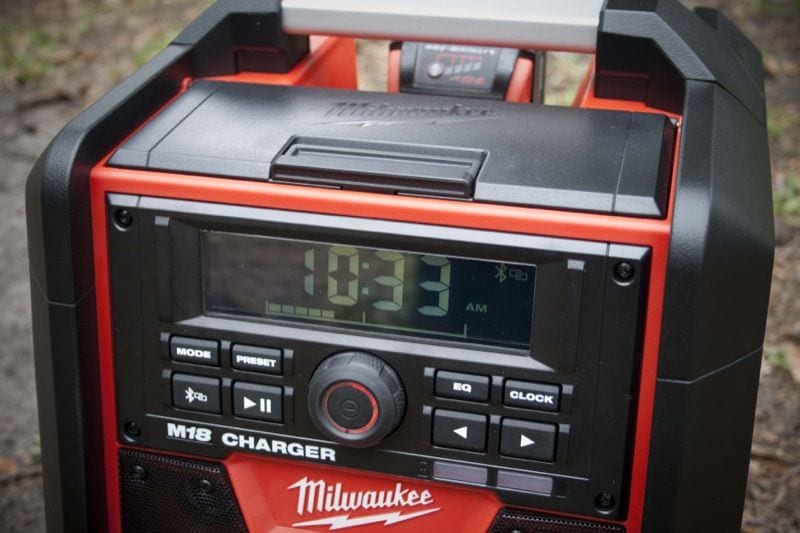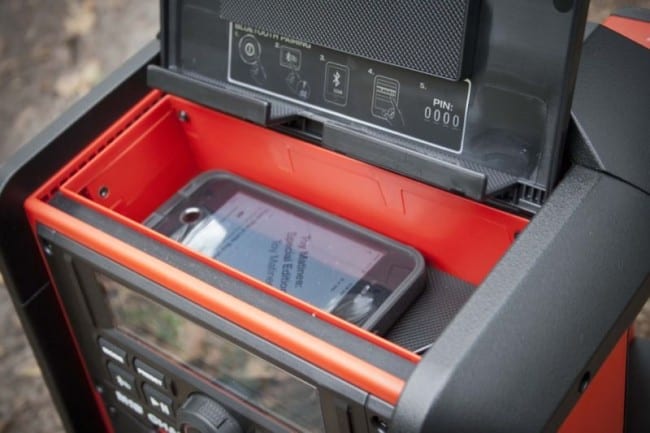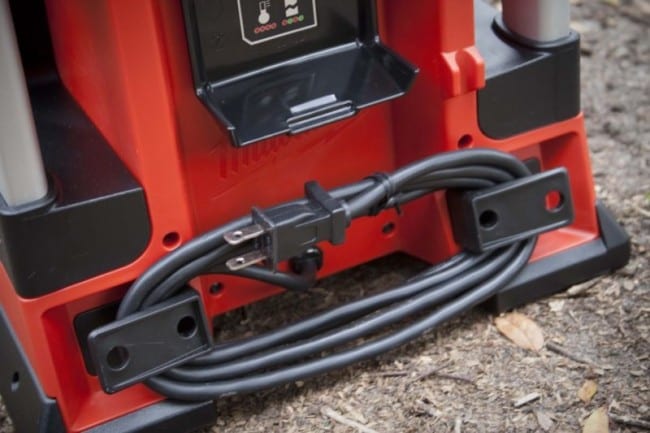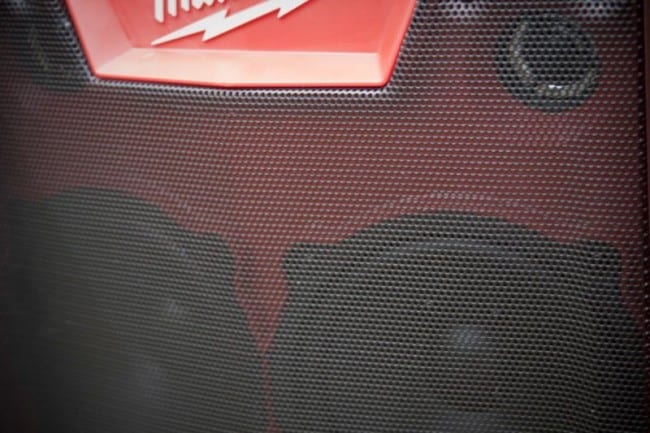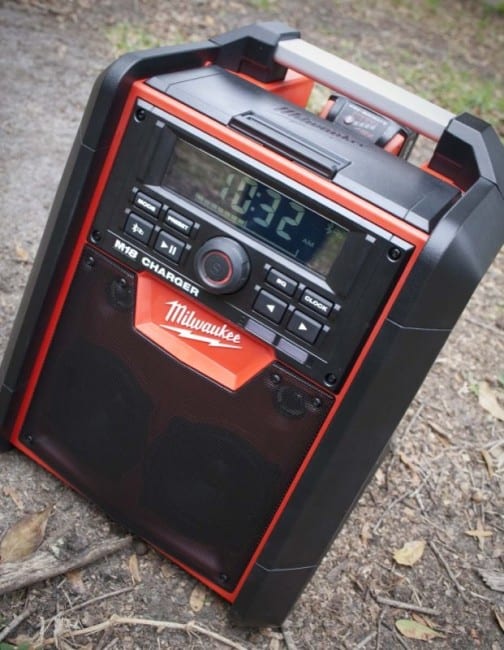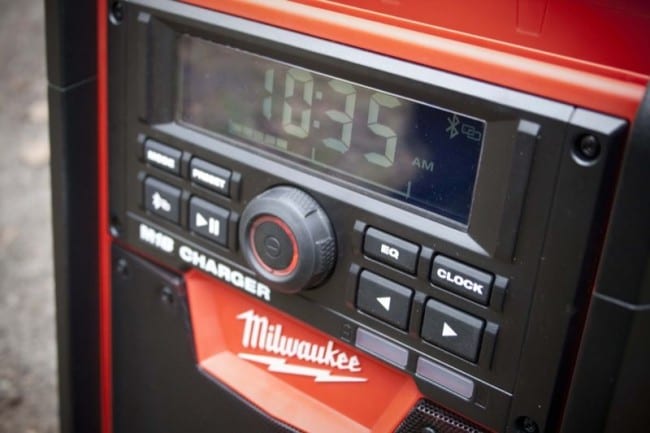It’s no secret that I love a good radio. My past is filled with years in post-production sound for feature films, television, and theme parks. I honestly can’t stand bad speakers or anything that aggressively distorts audio. So when Milwaukee dropped off their new M18 Charging Radio with Bluetooth (2792-20), I wanted to see if it lived up to the hype. Of course, we also couldn’t pass up the opportunity to do a Portable job site radios round-up.
Complete Milwaukee M18 Radio Redesign
Milwaukee’s 2792-20 is a complete redesign and bears very little resemblance to the 2790-20, despite it only being off by two digits on the model number. In fact, it has a completely new form factor. Instead of the low, wide stature of the 2790, the new model offers a more cubic shape that lends itself to easier positioning and greater portability and storage possibilities.
But the redesigned body of the Milwaukee M18 charging radio is only part of the picture. There are only a handful of full-size job site radios on the market that include a charger for lithium-ion batteries. You’ve got products from Ryobi, the Bosch PB10-CD PowerBox stereo, and the DeWALT DC012 worksite radio charger. Now, Milwaukee is throwing its hat into the ring.
Yes, It Charges M18 Batteries!
This is a huge feature upgrade. The new radio can charge a single M18 RedLithium battery which means that, while you’re listening to your tunes, you can be topping off the 4.0 Ah battery for your cordless impact driver. It also has another first for Milwaukee—Bluetooth audio support. Now, while you can still connect your smart phone or MP3 player to the radio via the included auxiliary jack, you can also opt to stream content to the radio wirelessly via Bluetooth.
Milwaukee used an older Bluetooth profile, so the connectivity uses a 4-digit pin, but since you only have to enter it once to pair a device, it wasn’t much of a hassle. I was up and running with my iPhone in about 60 seconds. If you want, you can store a phone or MP3 player inside the top of the unit, or flip open the lid of the weather-sealed auxiliary compartment and use it as a basic stand for an iPad or other tablet.
Milwaukee M18 Charging Radio Build Quality
Lest I forget, the new 2792-20 has similar protection to its preceding model—just in different places. Instead of four aluminum grab bars, you get a single top-mounted handle and twin vertical handles mounted on the rear-side. Suffice it to say, you won’t have any trouble finding a spot to grab the radio, regardless of how it’s positioned. The four corners as well as the base are generously protected by a plastic bumper that protrudes far enough away from the central case to provide protection against minor falls and accidents.
Not to be remiss, Milwaukee added their trademark bottles opener on the right rear side of the radio and the battery charger has a convenient flip cover to protect the leads when a battery isn’t docked in the sled. It’s nice touches like this that ensure this radio will be your go-to on-site charger for years to come. There is a convenient cord wrap on the rear of the radio to stow away the attached electrical cord, and I found it just the right shape and size to stow the entire length (8 feet).
The radio lacks any 120V outlets, so you can’t recoup a socket if you have it connected via an extension cord. It’s certainly not a deal-breaker, but it would have been nice to have. Clearly, Milwaukee is banking on the radio’s battery power source, or the fact that you can use it as a dual-use charger/radio.
Milwaukee M18 Charging Radio Specifications
- Battery: M18 RedLithium
- Charger: 18V charger
- Power: 40-watts
- Modes: FM/AM, Aux, Bluetooth
- USB Port: 2.1 Amps
- Aux port: 3.5mm (1/8-inch)
- Station Presets: 10
- Equalizer: Bass and treble
- Dimensions: 12 x 15 x 12 in
- Weight: 17 lbs
Listening Tests
I listened to the Milwaukee 2792-20 outdoors, on a job site no less. I measured the radio to determine its maximum SPL output. Using my trusty Radio Shack meter it came in at 94 dB SPL before any distortion kicked in—identical, in fact, to the 2790-20. I used the radio with FM, Bluetooth, and even the auxiliary input. Bluetooth and the aux input yielded the best results in terms of audio fidelity, but the tuner certainly played loudly—it just varied in quality based on the station and signal strength.
On SPL Levels and “Loudness”
When we review radios (or anything with a speaker) we tend to talk about this thing called “SPL”. SPL stands for “sound pressure level” and it refers to the loudness or the amount of volume a particular device can output. We typically measure SPL from 3 feet away using an SPL meter set to respond similarly to the way a human ear does (this is called ‘C’ weighting). To give you an idea of the difference between one SPL level and another, it takes about 10 dB SPL of measured sound to make the listener perceive a doubling of the volume. 104 dB SPL, therefore, is “twice as loud” as 94 dB SPL.
A Truly Full-Size Jobsite Radio
While small battery-powered radios are nifty and extremely portable, having a more full-sized solution is going to more easily fill the entire job site with music. I find this more desirable any time I’m working since I like to place the radio in a centralized location and hear it wherever I’m at. With a smaller radio, you just don’t get the same effect. Of course, with a larger radio you have to allocate more space, but the fact that the Milwaukee 2792-20 can also function as a battery charger, that’s one less thing I have to carry around with me.
Simplified Controls
Like the Milwaukee 2790-20, the new Milwaukee M18 charging radio 2792-20 doesn’t have an overabundance of buttons, The center button is oversized and functions as both a power button as well as a volume control. I much prefer a volume knob to a set up/down controls, so I have to give kudos to Milwaukee for making this change in this model. Other than that, the only other buttons control Play/Pause, Skip, EQ, Clock, Mode, Bluetooth, and Preset. Gone is the Scan button, now you just press and hold either the left or right buttons to get the radio to search for the next available station. That’s nine buttons in all, and each is easily utilized with even the thickest leather gloves.
The EQ button lets you control the Bass and Treble amounts with the central control knob. It may come in handy if you jump between indoors and outdoors as a method of controlling bass and keeping the radio from sounding boomy when it’s against a wall or positioned in a corner. Outdoors I preferred to run it flat (default).
USB, Aux, and Bluetooth
The onboard USB charger has enough juice to power my iPad—an important factor that lets me know it puts out close to 2.1A of power for newer power-hungry smartphones and tablets. Between Bluetooth and the Aux input, you have a myriad of ways to play your music while simultaneously charging your device.
The 2792-20 sounds good. It’s a great radio that doesn’t color the sound too much and distortion is only an issue if you’re determined to run it at absolute full volume. Keep it just under the max and it will put out lots of loud, clean music that sounds good and fills up even the largest of job sites.
Conclusion
Whether you’re on the roof, pouring concrete, framing a house or installing tile indoors, the $229 Milwaukee M18 Charging Radio with Bluetooth (2792-20) is going to provide endless hours of music while it charges your batteries. It’s a great radio that’s beautifully simple and doesn’t overcomplicate things with lots of features you’re likely not to use. In my opinion, that’s a large part of what defines a well-engineered product.

